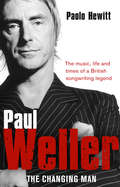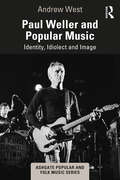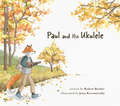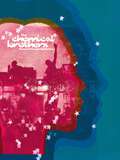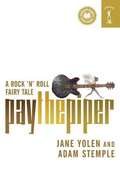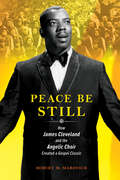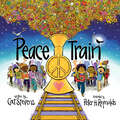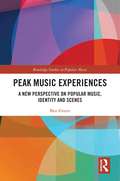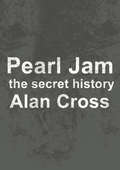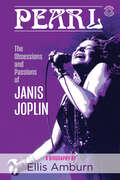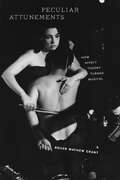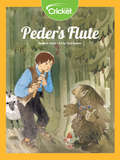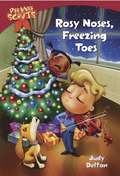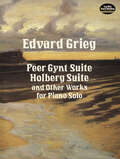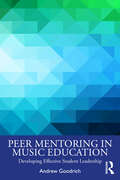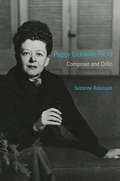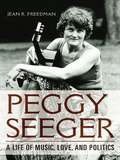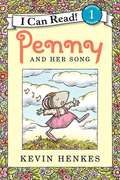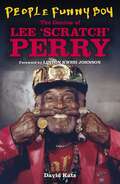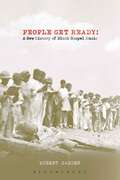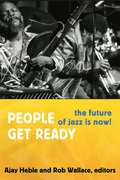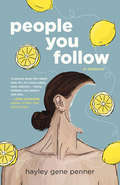- Table View
- List View
Paul Weller - The Changing Man
by Paolo HewittPaolo Hewitt has known Paul Weller since they were both teenagers in the depths of Woking, through his ascent to fame with The Jam, the halcyon years of The Style Council and for all of his critically acclaimed solo career. Hewitt has even been the inspiration for some of Weller's songs - and he has extraordinary in-depth knowledge of the inspiration behind the rest.Once, when Hewitt interviewed Weller for a music magazine, he complained - 'I don't know why people ask me all these questions. All the answers are in my songs.' Largely unnoticed, Weller has used thirty-years of lyrics to explore his personal history and beliefs. Taking as his starting point these lyrics, alongside a lifetime's friendship, Paolo Hewitt shows us the real Paul Weller, the man inside the music.
Paul Weller and Popular Music: Identity, Idiolect and Image (Ashgate Popular and Folk Music Series)
by Andrew WestUsing research, analysis and a range of historical sources, Paul Weller and Popular Music immerses the reader in the excitement of Paul Weller’s unique creative journey, covering topics such as the artist’s position within his field; his creative processes; the contexts in which the music was made; the artist as collaborator; signifiers that mark the trajectory of the music; and formative influences. Focusing on over 40 years of recorded work from ‘In the City’ to ‘Fat Pop (Volume One)’, this study explores why Paul Weller's music is widely considered both timeless and of its time, and with reference to a wide range of interviews, reviews and texts, it offers an in-depth critical analysis of Paul Weller’s music. It will be of particular interest to scholars and researchers of popular music, popular culture, performance studies and music production.
Paul and His Ukulele
by Robert BroderNot all who wander are lost, sometimes they're just searching for a new song.Paul was given a present. “A guitar?” said Paul. “It's a ukulele.” said his parents.Paul loved his ukulele and spent all his time crafting his own song. As he got older, Paul knew it was time to head out in search of something new.When his travels took him to one small town, the unexpected happened. But from unexpected circumstances can come new friendships and new experiences. And maybe that new song he's been looking for.
Paused in Cosmic Reflection
by The Chemical BrothersPaused in Cosmic Reflection is the definitive story of The Chemical Brothers. Told in the voices of Tom Rowlands and Ed Simons, with contributions from friends and collaborators, it is fully illustrated with 30 years of mind-bending visuals.
Paused in Cosmic Reflection
by The Chemical BrothersPaused in Cosmic Reflection is the definitive story of The Chemical Brothers. Told in the voices of Tom Rowlands and Ed Simons, with contributions from friends and collaborators, it is fully illustrated with 30 years of mind-bending visuals.
Pay the Piper: A Rock 'n' Roll Fairy Tale
by Jane Yolen Adam StempleA rock 'n' roll band to die for. When fourteen-year-old Callie McCallan scores a backstage pass to interview the lead singer of the famous band Brass Rat, she's thrilled. Peter Gringras is so cool. When he plays his flute, it's as if he has some kind of hypnotic power. But there is something strange about him, something Callie can't quite put her finger on. Then, on Halloween night, Callie's little brother Nicky disappears, along with all the other children in town. It's crazy, but Callie thinks she knows where the children have gone--and who took them. To prove it, and to rescue Nicky and the other children, Callie must journey to a mythical world filled with fantastical creatures. A world from which there may be no return.
Peace Be Still: How James Cleveland and the Angelic Choir Created a Gospel Classic (Music in American Life)
by Robert MarovichIn September of 1963, Reverend Lawrence Roberts and the Angelic Choir of the First Baptist Church of Nutley, New Jersey, teamed with rising gospel star James Cleveland to record Peace Be Still. The LP and its haunting title track became a phenomenon. Robert M. Marovich draws on extensive oral interviews and archival research to chart the history of Peace Be Still and the people who created it. Emerging from an established gospel music milieu, Peace Be Still spent several years as the bestselling gospel album of all time. As such, it forged a template for live recordings of services that transformed the gospel music business and Black worship. Marovich also delves into the music's connection to fans and churchgoers, its enormous popularity then and now, and the influence of the Civil Rights Movement on the music's message and reception. The first in-depth history of a foundational recording, Peace Be Still shines a spotlight on the people and times that created a gospel music touchstone.
Peace Train
by Cat StevensThe instant #1 New York Times and Indie bestseller!Hop aboard the Peace Train in this picture book adaptation of Cat Stevens’s legendary anthem of unity and harmony in time for the song’s 50th anniversary! With illustrations by New York Times bestselling illustrator Peter H. Reynolds.“Now I've been happy lately Thinking about the good things to come And I believe it could be Something good has begunOh, I've been smiling lately Dreaming about the world as one And I believe it could be Someday it's going to come”Readers are invited to hop on the PEACE TRAIN and join its growing group of passengers who are all ready to unite the world in peace and harmony.Featuring the timeless lyrics of Cat Stevens’s legendary song and illustrations by New York Times bestselling artist Peter H. Reynolds, this hopeful picture book inspires tolerance and love for people of all cultures and identities.
Peak Music Experiences: A New Perspective on Popular music, Identity and Scenes (Routledge Studies in Popular Music)
by Ben GreenPeak music experiences are a recurring feature of popular music journalism, biography and fan culture, where they are often credited as pivotal in people’s relationships with music and in their lives more generally. Ben Green investigates the phenomenon from a social and cultural perspective, including discussions of peak music experiences as sources of inspiration and influence; as a core motivation for ongoing musical and social activity; the significance of live music experiences; and the key role of peak music experiences in defining and perpetuating music scenes. The book draws from both global media analysis and situated ethnographic research in the dance, hip hop, indie and rock ‘n’ roll music scenes of Brisbane, Australia, including participant observation and in-depth interviews. These case studies demonstrate the methodological value of peak music experiences as a lens through which to understand individual and collective musical life. The theoretical analysis is interwoven with selected interview data, illuminating the profound and everyday ways that music informs people’s lives. The book will therefore be of interest to the interdisciplinary field of popular music studies as well as sociology and cultural studies beyond the study of music.
Pearl Jam: The Secret History (The\secret History Of Rock Ser.)
by Alan CrossAlan Cross is the preeminent chronicler of popular music.Here he provides a short history of Pearl Jam from their founding through the year 2000.This look at the "anti-stars from Seattle" is adapted from the audiobook of the same name.
Pearl: The Obsessions and Passions of Janis Joplin
by Ellis AmburnThe definitive biography of the 1960s music legend covers her trailblazing life from troubled childhood to iconic stardom to her tragically early death.A wild child of the Texas-Louisiana swamps, Janis Joplin wailed the blues like no one before had ever dared. She was the first rock star of the 1960s counterculture, a fashion trendsetter in San Francisco’s back-to-the-roots movement that overtook the world, and a prisoner of an ultimately doomed search for happiness in sex, drugs, money, and fame. But to those who knew and loved her intimately, she was Pearl. Acclaimed music biographer Ellis Amburn reveals the true life story of this immortal legend. From her backwater Texas childhood where classmates punished her for her individuality, Amburn charts her unlikely rise to stardom and affairs with fellow music legends including Jim Morrison, Kris Kristofferson, and Jimi Hendrix. Amburn also chronicles her losing battles with addiction, insecurity, and other forces that drove her through a short, impulsive life, to death by overdose at the age of twenty-seven.
Peculiar Attunements: How Affect Theory Turned Musical
by Roger Mathew GrantPeculiar Attunements places the recent turn to affect into conversation with a parallel movement in European music theory of the eighteenth century. During that time the affects—or passions, as they were also called—formed a vital component of a mimetic model of the arts. Eighteenth-century critics held that artworks imitated or copied the natural world in order to produce copies of the affects in their beholders. But music caused a problem for such theories, since it wasn’t apparent that musical tones could imitate anything with any dependability, beyond the rare thunderclap or birdcall.Struggling to articulate how it was that music managed to move its auditors without imitation, certain theorists developed a new affect theory crafted especially for music, postulating that music’s physical materiality as sound vibrated the nerves of listeners and attuned them to the affects through sympathetic resonance. This was a theory of affective attunement that bypassed the entire structure of representation, offering a non-discursive, corporeal alternative. It is a pendant to contemporary theories of affect, and one from which they have much to learn. Inflecting our current intellectual moment through eighteenth-century music theory and aesthetics, this book offers a reassessment of affect theory’s common systems and processes. It offers a new way of thinking through affect dialectically, drawing attention to patterns and problems in affect theory that we have been given to repeating. Finally, taking a cue from eighteenth-century theory, it gives renewed attention to the objects that generate affects in subjects.
Peder's Flute
by Mark OlsonPeder works hard every day, taking care of his family’s farm with no help from his lazy brothers. He doesn’t mind, though—he gets to play his flute while he works. After his playing attracts the attention of a wealthy troll king, his brothers become jealous of the rewards the king offers to him. They hatch a plan to collect Peder’s reward for themselves. Will the king see through their ploy?
Pee Wee Scouts: Rosy Noses, Freezing Toes (Pee Wee Scouts)
by Judy Delton illustrated by Alan TiegreenJINGLE BELL ROCK Stars? The Scouts are having a holiday party to show off their musical talents. Molly plans to sing “Rudolph the Red-Nosed Reindeer. ” And Rachel wants to perform Hanukkah songs on the piano. But notallthe Scouts are ready for the concert. Sonny hates the violin so much, he’d rather run away from home than play it! He disappears, and the Pee Wees have to work together to find their friend. Can they bring Sonny home for the holidays?
Peer Gynt Suite, Holberg Suite, and Other Works for Piano Solo
by Edvard GriegTreasury of piano music by great Norwegian composer, including the perennial favorites, Peer Gynt Suites Nos. 1 and 2 and the Holberg Suite, as well as a rich selection of other pieces: Vier Stucke, Op. 1, Humoresker, Op. 6, Sonata in E Minor, Op. 7, Zwei elegische Melodien, Op. 34, Stimmungen, Op. 73 and many others. Authoritative C. F. Peters edition.
Peer Mentoring in Music Education: Developing Effective Student Leadership
by Andrew GoodrichPeer Mentoring in Music Education: Developing Effective Student Leadership offers a practical guide to peer mentoring in music education, enabling music teachers to implement and benefit from this technique with their students. Drawing on extensive and current research in education and music education, the core focus of this book is on the instructional practice of peer mentoring and how students can become effective leaders. Through case studies and examples focused on music education, the author shows how peer mentoring can transform learning for all students and foster student leadership as part of a student-centered instructional approach. Part I explores the foundations of these instructional practices, the role of the music teacher, the role of the student, and how socializing and student leadership contribute to meaningful learning. Part II portrays stories of four exemplary music teachers who use peer mentoring and student leadership in their music programs across a wide array of age levels and music classes and ensembles. Music teachers will benefit from learning about the transformative power of peer mentoring and student leadership, and how these instructional practices aid with diversity, equity, inclusion, and access so that all students are valued in the music class and ensemble. Peer Mentoring in Music Education: Developing Effective Student Leadership provides a comprehensive guide for in-service and preservice music teachers seeking to understand peer mentoring and incorporate this technique in teaching.
Peggy Glanville-Hicks: Composer and Critic (Music in American Life)
by Suzanne RobinsonAs both composer and critic, Peggy Glanville-Hicks contributed to the astonishing cultural ferment of the mid-twentieth century. Her forceful voice as a writer and commentator helped shape professional and public opinion on the state of American composing. The seventy musical works she composed ranged from celebrated operas like Nausicaa to intimate, jewel-like compositions created for friends. Her circle included figures like Virgil Thomson, Paul Bowles, John Cage, and Yehudi Menuhin. Drawing on interviews, archival research, and fifty-four years of extraordinary pocket diaries, Suzanne Robinson places Glanville-Hicks within the history of American music and composers. "P.G.H."--affectionately described as "Australian and pushy"--forged alliances with power brokers and artists that gained her entrance to core American cultural entities such as the League of Composers, New York Herald Tribune, and the Harkness Ballet. Yet her impeccably cultivated public image concealed a private life marked by unhappy love affairs, stubborn poverty, and the painstaking creation of her artistic works. Evocative and intricate, Peggy Glanville-Hicks clears away decades of myth and storytelling to provide a portrait of a remarkable figure and her times.
Peggy Seeger: A Life of Music, Love, and Politics
by Jean R. FreedmanBorn into folk music's first family, Peggy Seeger has blazed her own trail artistically and personally. Jean Freedman draws on a wealth of research and conversations with Seeger to tell the life story of one of music's most charismatic performers and tireless advocates. Here is the story of Seeger's multifaceted career, from her youth to her pivotal role in the American and British folk revivals, from her instrumental virtuosity to her tireless work on behalf of environmental and feminist causes, from wry reflections on the U.K. folk scene to decades as a songwriter. Freedman also delves into Seeger's fruitful partnership with Ewan MacColl and a multitude of contributions which include creating the renowned Festivals of Fools, founding Blackthorne Records, masterminding the legendary Radio Ballads documentaries, and mentoring performers in the often-fraught atmosphere of The Critics Group. Bracingly candid and as passionate as its subject, Peggy Seeger is the first book-length biography of a life set to music.
Pennington's Heir (Pennington #3)
by K. M. PeytonGetting out of prison was like being born again, said Patrick Pennington. His adoring girl friend, seventeen-year-old Ruth Hollis, was waiting for him. Professor Hampton, Pat's piano teacher, had waited, too, for his impetuous star pupil to get out and get back to his music again. Now it looked like a sure, straight road to success, if Pat could just keep himself out of trouble and stick with his studies. But trouble and Pat Pennington have an affinity for each other. When Ruth tells him she is going to have his baby, Pat must face a new kind of problem--one that threatens both his personal happiness and his future as a concert pianist. Patrick Pennington, the rebellious and talented anti-hero of Pennington's Last Term and The Beethoven Medal, doesn't settle easily into the role of husband, father, and breadwinner. With humor, compassion, and deep insight, K. M. Peyton portrays a very young, very loving couple's rocky first year of marriage.
Penny And Her Song (I Can Read Level 1 Series)
by Kevin HenkesWhen Penny comes home from school, she is ready to sing her song. But the babies are sleeping, and Mama and Papa are worried that Penny will wake them up. Oh, but it is a good song, a really wonderful song . . . and Penny wants more than anything to sing it. What do you think will happen?
People Funny Boy: The Genius of Lee 'Scratch' Perry
by David Katz'David Katz's in-depth portrayal of his genius is to be commended and is an essential addition to any serious music fan's collection' David Rodigan MBE OD'For the complete picture of this musical genius you can't get better than David Katz's People Funny Boy - if you're into Scratch, it's essential' Don LettsArguably the most influential force in Jamaican music, Lee Perry brought Bob Marley to international stardom and has since collaborated with artists such as Sir Paul McCartney, The Clash and The Beastie Boys. The book delves behind the myth of Perry to give a fuller examination of his life and work through extensive interviews with family members, fellow artists, friends, lovers, enemies, as well as the man himself to present a complex portrait of a unique soul driven by unseen spiritual forces. This revised and expanded edition has been thoroughly updated and completely overhauled to render a more nuanced, accurate and accessible read, with new information on Perry's later years, including his Grammy Award, cessation of herb smoking and final passing, as well as previously unpublished information about his early life, his unique relationship with Marley, and his fabled Black Ark studio.
People Funny Boy: The Genius of Lee 'Scratch' Perry
by David Katz'David Katz's in-depth portrayal of his genius is to be commended and is an essential addition to any serious music fan's collection' David Rodigan MBE OD'For the complete picture of this musical genius you can't get better than David Katz's People Funny Boy - if you're into Scratch, it's essential' Don LettsArguably the most influential force in Jamaican music, Lee Perry brought Bob Marley to international stardom and has since collaborated with artists such as Sir Paul McCartney, The Clash and The Beastie Boys. The book delves behind the myth of Perry to give a fuller examination of his life and work through extensive interviews with family members, fellow artists, friends, lovers, enemies, as well as the man himself to present a complex portrait of a unique soul driven by unseen spiritual forces. This revised and expanded edition has been thoroughly updated and completely overhauled to render a more nuanced, accurate and accessible read, with new information on Perry's later years, including his Grammy Award, cessation of herb smoking and final passing, as well as previously unpublished information about his early life, his unique relationship with Marley, and his fabled Black Ark studio.
People Get Ready!: A New History Of Black Gospel Music
by Robert DardenPeople Get Ready!: A New History of Gospel Music is a passionate, celebratory, and carefully researched chronology of one of America's greatest treasures. From Africa through the spirituals, from minstrel music through jubilee, and from traditional to contemporary gospel, People Get Ready! shows the links between styles, social patterns, and artists. The emphasis is on the stories behind the songs and musicians. From the nameless slaves of Colonial America to Donnie McClurkin, Yolanda Adams, and Kirk Franklin, People Get Ready! provides, for the first time, an accessible overview of this musical genre. In addition to the more familiar stories of Thomas A. Dorsey and Mahalia Jackson, the book offers intriguing new insights into the often forgotten era between the Civil War and the rise of jubilee-that most intriguing blend of minstrel music, barbershop harmonies, and the spiritual. Also chronicled are the connections between some of gospel's precursors (Blind Willie Johnson, Arizona Dranes, and Sister Rosetta Tharpe) and modern gospel stars, including Andrae Crouch and Clara Ward. People Get Ready! knits together a number of narratives, and combines history, musicology and spirituality into a coherent whole, stitched together by the stories of dozens of famous and forgotten musical geniuses.
People Get Ready: The Future of Jazz Is Now!
by Rob Wallace Heble AjayIn People Get Ready, musicians, scholars, and journalists write about jazz since 1965, the year that Curtis Mayfield composed the famous civil rights anthem that gives this collection its title. The contributors emphasize how the political consciousness that infused jazz in the 1960s and early 1970s has informed jazz in the years since then. They bring nuance to historical accounts of the avant-garde, the New Thing, Free Jazz, "non-idiomatic" improvisation, fusion, and other forms of jazz that have flourished since the 1960s, and they reveal the contemporary relevance of those musical practices. Many of the participants in the jazz scenes discussed are still active performers. A photographic essay captures some of them in candid moments before performances. Other pieces revise standard accounts of well-known jazz figures, such as Duke Ellington, and lesser-known musicians, including Jeanne Lee; delve into how money, class, space, and economics affect the performance of experimental music; and take up the question of how digital technology influences improvisation. People Get Ready offers a vision for the future of jazz based on an appreciation of the complexity of its past and the abundance of innovation in the present. Contributors. Tamar Barzel, John Brackett, Douglas Ewart, Ajay Heble, Vijay Iyer, Thomas King, Tracy McMullen, Paul D. Miller/DJ Spooky, Nicole Mitchell, Roscoe Mitchell, Famoudou Don Moye, Aldon Lynn Nielsen, Eric Porter, Marc Ribot, Matana Roberts, Jaribu Shahid, Julie Dawn Smith, Wadada Leo Smith, Alan Stanbridge, John Szwed, Greg Tate, Scott Thomson, Rob Wallace, Ellen Waterman, Corey Wilkes
People You Follow: A Memoir
by Hayley Gene Penner“A journey down the rabbit hole of LA's most subtly toxic industry ... funny, brilliant, coy, playful, and wise.” — LENA DUNHAM, author of Not That Kind of Girl Musician Hayley Gene Penner tells all in this harrowingly honest memoir. Singer-songwriter Hayley Gene Penner's memoir takes a brutally honest yet humorous look at the dark, intimate truths we spend our lives running from. Like a map of beautiful mistakes, Hayley’s stories of questionable sexual encounters, artistic aspirations, and emotional abuse trace her coming of age in the music industry. Hayley explores all her relationships — from her childhood as the daughter of a celebrity, to the destructive and coercive relationship with her boss, to her encounter with the actor we all know but who mustn’t be named — and brings them together in a series of sharp, touching vignettes. People You Follow straddles the delicate boundary between ethical and unethical behaviour, self-protection and self-destruction, power and weakness, giddiness and despair.
